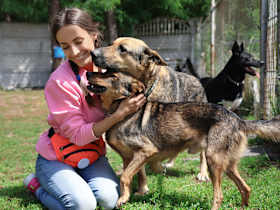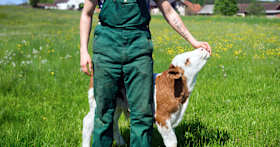What to Consider When Adopting a Snake
These reptiles make for surprisingly sweet pets. Here’s how to prepare yourself for all the responsibilities involved with becoming a snake pet parent.
These reptiles make for surprisingly sweet pets. Here’s how to prepare yourself for all the responsibilities involved with becoming a snake pet parent.
by Dahlia Ghabour, | May 29, 2025

Vero. / Stocksy
Snakes can make excellent pets when given the correct care. They may seem like low-responsibility pets, but snakes require specific care, including enclosures with temperature regulations, hiding spots, and secure lids. They also require strict feeding requirements and vet care.
Pets can be a huge commitment of time, energy, and money, and any exotic pet — snakes, among them — should be thoroughly researched before being added to your family. With that in mind, we created a helpful guide for the snake-curious to determine if this reptile is the right pet for you.
There are several questions you should ask yourself first.
Do you have space in your house for their enclosure?
Are you comfortable handling dead rodents and birds, which snakes eat?
Are you prepared for them to live long lives?
Are you familiar with their specific care?
Snakes can be gentle, adorable pets and companions. But they’re not as self-sufficient as people assume they are, and will rely on you for their well-being. Raising a snake is a responsibility, as with any other pet.
Adopting a snake should not be an impulse decision. They require rigid feeding schedules and diets, specific enclosures, and have long lifespans, so it’s not a commitment to be taken lightly. Here are some important things to consider before adopting a snake.
Be prepared to care for your snake for a long time: Snakes can live for 15 to 25 years in captivity, depending on their species and care. Ball pythons, for example, live 15 to 20 years, while corn snakes live 10 to 15 years. The best snake pet for you will be the one you can care for their entire life.
Snakes don’t follow a typical feeding schedule for pets, so be aware of that. Snakes eat once a week on average, with the most common pet snakes eating every 10 to 14 days. Keeping a record of your pet snake’s food and feeding schedule is important for several reasons, including nutritional balance, watching for any changes in appetite, and providing information to vets. Make sure to ask your vet or animal shelter for guidance on your specific snake’s nutritional needs.
Snakes mostly eat small mammals, such as mice and voles, in the wild. Since they can’t chew, snakes eat by stretching their jaws to swallow prey whole, then digest slowly. You may think pet snakes should be fed live food, but even a small mouse bite can cause them to get an infection.
Instead, train your pet snake to eat dead prey, including thawed, previously frozen prey or freshly killed prey. Most pet stores will offer both freshly killed and frozen rodents. You’ll have to get used to storing them in your freezer, of course.
Unlike cats and dogs, a snake needs to live in their own, separate environment within a specialized enclosure. This enclosure needs to be large enough for your snake to fully stretch out — at minimum. It must also be at least half as wide as your snake is tall, sufficiently ventilated, with a tight, escape-proof lid. Snakes are well-known as escape artists.
Snakes cannot regulate their body temperatures, so each enclosure will need the following:
A high-quality heat source or basking bulb
UVB lighting, so you can see your snake
A basking zone
Monitored humidity levels and temperatures
A hiding place
Reptile bedding, such as substrate
A water source
Locking clips
Snakes make great pets, but they’re picky in lots of ways. Some surprises to keep on your radar.
Snakes are temperature sensitive: All snakes are ectotherms, which means they can’t generate heat from their bodies and need to get it from their environments. This means your enclosure needs the perfect temperature, humidity, and water levels. If a snake is not well cared for, they can develop hypothermia.
Some don’t like being handled: Snakes don’t typically like to be pet, and many will not like being handled at all. Each snake has a different personality, so be gentle.
You’ll need to find an exotic vet: You can’t take a snake to a regular vet. Reptiles, birds, horses, and other exotic animals require specialized care.
Snakes need large enclosures: If you live in an apartment or small space, a snake may not be the best pet for you. Proper snake enclosures need to be large enough for the snake to stretch out completely at the very least.
Snakes are escape artists: Snakes are strong, love burrowing, and will try to get out of any enclosure. (Small snakes such as corn snakes are particularly good at this.) So you must be careful and vigilant with them.
Setting up your snake’s terrarium will cost the most, from about $300 to $1,000, depending on your pet’s size. After that, your yearly costs will vary depending on your snake’s diet, how often your snake eats, and electricity costs for the heat bulb. You may be able to bulk-buy food to save money and get a good deal on watt panels, heat tape, or space heaters. Heating costs could be $20 to $40 a month, with frozen mice about $100 per year.
A snake could cost between $25 and $100 to adopt, depending on their age, breed, and health. Adopting a snake from a breeder will typically cost more than adopting from a shelter or animal rescue through Adopt a Pet, both of which connect you with snakes who need homes.
The species you choose will determine the snake’s cost. For instance, Ball Pythons are typically budget-friendly and less than $70 to adopt, while corn snakes can be more pricey since they’re so popular. Don’t forget to factor in the cost of exotic-pet vet care, though you may be able to secure some financial assistance for this.
You can adopt a snake from reputable breeders, shelters, or animal rescue organizations. You can also search sites such as Adopt a Pet. If you’re struggling to find snake organizations near you, your local exotic-pet vet or animal shelter may be able to refer you to additional rescue groups.
First-time snake parents should avoid large constricting snakes or venomous snakes. Some of the best snakes for beginners include Corn snakes (docile and easy to handle), King snakes (small to average size), Milk snakes (vividly colored and easy to handle), Ball Pythons (heavy-bodied, long-living, and shy), Hognose snakes (docile and playful), and Rosy Boas (gentle and not too large).
Snakes will recognize their pet parents and develop some kind of bond, but not in the way a dog or cat would. Your pet snake’s attachment level will likely depend on their breed. The more time you spend with your snake, the better your relationship and bond will be. Establish a good foundation of trust with a comfortable enclosure. Consistent handling and positive interactions can help your snake become more fond of you.
“Eastern Corn Snake.” Smithsonian’s National Zoo & Conservation Biology Institute. nationalzoo.si.edu/animals/eastern-corn-snake.
Kruzer, Adrienne. “Do Snakes Like Being Pet?” The Spruce Pets. www.thesprucepets.com/do-snakes-like-being-pet-5195042.
“Life Cycle of a Snake: Reproduction & Removal.” Critter Control. www.crittercontrol.com/wildlife/snakes/snake-life-cycle.
Perry, Sean. “Hypothermia in Reptiles.” PetMD by Chewy. www.petmd.com/reptile/conditions/systemic/hypothermia-reptiles.
“Reptile Rapture Rescue.” Reptile Rapture. reptilerapture.net/rescued-reptiles.html.
Rich, Gregory, Hess, Laurie, and Axelson, Rick. “Feeding Pet Snakes.” VCA Animal Hospitals. vcahospitals.com/know-your-pet/snakes-feeding.
Selvaggio, Lisa. “Snake Housing: How to set up a snake enclosure.” Chewy. vcahospitals.com/know-your-pet/snakes-feeding.
“Snake Discovery: Adoption Island.” Snake Discovery. snakediscovery.com/adoption-program.
“Snakes as Pets.” Vet MD, Texas A&M University. vetmed.tamu.edu/news/pet-talk/snakes-as-pets.
“Snake Feeding Record.” Evolution Reptiles. https://www.evolutionreptiles.co.uk/care-hub/reptile-care-checklists/reptile-feeding-chart/?srsltid=AfmBOoq_Y9qxdEi9_z1saUkzZj_AIsKILbKQQTQPBTC8hPcHzm27WHZy.
“Top 5 Beginner-Friendly Pet Snakes According to Vets.” geniusvets.com. www.geniusvets.com/pet-care/learn/reptiles/snakes/blog/top-5-beginner-friendly-pet-snakes-according-vets.
Zayas, Maria. “What do Snakes Eat?” PetMD by Chewy. https://www.petmd.com/reptile/nutrition/what-do-pet-snakes-eat.

Dahlia Ghabour is a Louisville, Kentucky-based freelance writer with award-winning work featured in newspapers such as the Louisville Courier-Journal and the Jacksonville Business Journal, both online and in print. Dahlia has two gray cats, a love of wildlife and zoo conservation, and a deep desire to one day pet a cheetah.

Adoption Advice

Adoption Advice

Shelters & Rescue

Adoption Advice
Are you finalizing a new pet’s adoption? Learn everything you need to know about pet adoption paperwork.

Foster & Volunteer
Sometimes, people aren’t approved for fostering. But the good news is that this rejection is nothing to take personally, and there’s no reason you can’t reapply later.

Adoption Advice
Hesitant to adopt a pet? We break down common adoption worries and offer practical tips for a smooth transition.

Adoption Advice
Considering a mini pig, cow, or goat? This guide will help you understand the ins and outs of their care, before bringing one home.

Shelters & Rescue
Inside all the safeguards, limitations, and obstacles of the state and federal laws aimed at protecting animals — and how this may affect you.

Breed Info
Looking for a pup to match your lifestyle? These are the top canine companions of the year, perfect for everyone from adventurers to couch potatoes.